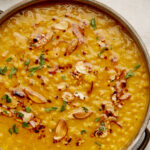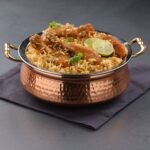<script async src="https://pagead2.googlesyndication.com/pagead/js/adsbygoogle.js?client=ca-pub-6514684778874346"
crossorigin="anonymous"></script>
Upma is a popular South Indian breakfast made with cream of wheat or semolina flour (called rava or suji locally), veggies, spices and herbs. The upma recipe I share here is adapted from my mom’s recipe and continues to be a favorite in my home. The ingredients used to flavor the rava upma (also called suji ka upma) give it a deliciously satisfying taste that will make this dish one of your new preferred go-to breakfasts.
Topping Marzipan Tart Cheesecake Sweet Lollipop
Course: Aperitives, BreakfastCuisine: Indian, South IndianDifficulty: Easy3
servings15
minutes15
minutes300
kcalIngredients
1 cup rava – finer variety (sooji or cream of wheat or semolina)
2 tablespoons Ghee (clarified butter) or oil
1 teaspoon mustard seeds
½ teaspoon cumin seeds
1 teaspoon chana dal (split and husked bengal gram)
1 teaspoon urad dal (split and husked black gram)
10 to 12 cashews (optional)
⅓ cup finely chopped onions or 1 medium-sized onion
1 teaspoon chopped green chilli or 1 green chilli
1 teaspoon finely chopped ginger or 1 inch ginger
1 sprig curry leaves or 10 to 12 curry leaves
2.5 cups water
salt as required
1 to 2 teaspoons sugar or add as required – optional
2 tablespoons chopped coriander leaves (cilantro)
Directions
- Finely chop 1 medium sized onion, 1 to 2 green chillies and 1 inch ginger and some coriander leaves.
- Also set aside the remaining ingredients.
- Roasting rava
- Heat a pan or kadai first. Add rava or cream of wheat.
- Begin to roast the rava. Stir often while roasting the rava.
- The rava or sooji grains should become fragrant and start to look dry, separate and crisp. Don’t brown the rava.
- Switch off the flame and then add the roasted rava in a plate and keep aside.
- Frying and sautéing
- In a pan, heat ghee or oil. add the mustard seeds.
- When you hear the crackling sound of mustard seeds, it means they are getting fried.
- Now add the cumin seeds along with chana dal and urad dal.
- Fry till they begin to brown a bit or get lightly golden
- Immediately add cashews and begin to fry. By the time, the cashews get golden the lentils will also get golden.
- Now add the finely chopped onions. Saute the onions till they become translucent.
- Then add the chopped green chilly, ginger, curry leaves. Sauté for a few seconds. You can also add 1 dried red chilli at this step.
- Boiling water
- Then add 2.5 cups water, sugar and salt as required. Mix well and check the taste of water. It should be a bit salty but not too much.
- Sugar is optional and you can skip it.
- On a medium to high flame, heat the water and let it come to a rolling boiling.
- Making upma
- When the water comes to a rolling boil, lower the flame to its lowest. Then add the rava in 4 to 5 batches with a spoon.
- Once you add the rava, mix and stir immediately. The entire batch of rava should get mixed with the water evenly. Then add the next batch of roasted rava. Mix and stir again.
- This way keep on adding and stirring the rava up to the last batch.
- Quickly stir and mix well. The rava grains absorb water and thus swell and get cooked.
- Cover and allow the rava upma to steam for 2 to 3 minutes on a low heat.
- Then switch off the flame. Here the rava is cooked and the upma is ready.
- Lastly add chopped coriander leaves. Mix again.
- Serve upma with coconut chutney or lime slices or lime pickle.
Notes
- Roasting rava: The rava has to be roasted evenly. For this you need to stir rava often on a low or medium-low heat of the pan. See for the signs of the color change and the rava granules looking separate, crisp with a nice toasted aroma.
- Adding rava in batches: Always add rava to the hot water in batches. After adding each batch mix the rava evenly with the water. This will make sure that your upma will turn smooth and soft.
- Avoiding lumpy and sticky upma: To avoid lumps add rava in batches and mix each batch of rava very well with the water. Remember to use fine rava for this recipe. If you use a coarser rava, you will have to add more water so that it does not become lumpy. If the rava is not roasted properly the upma will become sticky.
- Oil or ghee: You can easily make upma with either oil or ghee. With ghee the upma tastes better though. You can even drizzle a bit of ghee when serving upma.
- Rava and water proportion: For a softer rava upma, you can use the proportion of 1:2.5 or 3 for rava and water respectively. Which means that for 1 cup of fine rava you can add 2.5 to 3 cups water.
- Serving suggestions: Upma is best served hot or warm. You can top it up with some sev or bhujia with a drizzle of lemon juice. You can even serve upma with coconut chutney or lemon pickle or idli podi.
- Scaling and storing: You can easily halve or double this recipe. Leftover upma can be refrigerated for a couple of days. You can even freeze it. While reheating, sprinkle some water and reheat the upma in a pan or microwave.





